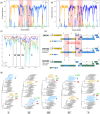Benefits of HIV-1 transmission cluster surveillance: a French retrospective observational study of the molecular and epidemiological co-evolution of recent circulating recombinant forms 94 and 132
- PMID: 39875664
- PMCID: PMC11774651
- DOI: 10.1002/jia2.26416
Benefits of HIV-1 transmission cluster surveillance: a French retrospective observational study of the molecular and epidemiological co-evolution of recent circulating recombinant forms 94 and 132
Abstract
Introduction: Molecular surveillance is an important tool for detecting chains of transmission and controlling the HIV epidemic. This can also improve our knowledge of molecular and epidemiological factors for the optimization of prevention. Our objective was to illustrate this by studying the molecular and epidemiological evolution of the cluster including the new circulating recombinant form (CRF) 94_cpx of HIV-1, detected in 2017 and targeted by preventive actions in 2018.
Methods: In June 2022, 32 HIV-1 sequence databases from French laboratories were screened to identify all individuals who had acquired CRF94_cpx or a similar strain, whatever the date of diagnosis. Phylogenetic analyses were performed with the sequences identified, and biological parameters were collected at the time of diagnosis and after the start of treatment to analyse the evolution of the cluster. Full genomes were sequenced to characterize the new strains.
Results: We analysed 98 HIV-1 isolates: 63 were CRF94, three were unclassifiable, and the other 32 formed a new cluster containing a new recombinant, CRF132_94B, derived from CRF94 and a subtype B strain. At least 95% of the individuals in both the CRF94 and CRF132 clusters were men who have sex with men (MSM), most of whom had acquired HIV less than 12 months before diagnosis. The number of CRF94 diagnoses declined drastically after 2018, but CRF132 strains spread widely between 2020 and 2022, into a different area of Ile-de-France region and within a younger population nevertheless aware of pre-exposure prophylaxis. Higher viraemia, lower CD4 cell counts and delayed treatment efficacy suggested that CRF94 was more virulent than CRF132, possibly due to the F subtype fragment of the vif gene.
Conclusions: These findings highlight the role of the MSM transmission cluster in spreading HIV and new variants. They show also the benefits of cluster surveillance for improving the targeting of preventive interventions, detecting the emergence of new strains and enriching our knowledge on virulence mechanisms. However, these investigations require support with sufficient resources dedicated to a regional or national programme to be responsive and effective.
Keywords: CRF132; CRF94; HIV prevention; HIV‐1; cluster of transmission; molecular surveillance.
© 2025 The Author(s). Journal of the International AIDS Society published by John Wiley & Sons Ltd on behalf of the International AIDS Society.
Conflict of interest statement
The authors have no competing interests.
Figures




References
-
- HIV—Global [Internet]. [cited 2024 Oct 25]. Available from: https://www.who.int/health‐topics/hiv‐aids
-
- Haar K, Amato‐Gauci AJ. European men who have sex with men still at risk of HIV infection despite three decades of prevention efforts. Euro Surveill. 2015;20(14):21087. - PubMed
Publication types
MeSH terms
Grants and funding
LinkOut - more resources
Full Text Sources
Medical
Molecular Biology Databases
Research Materials

